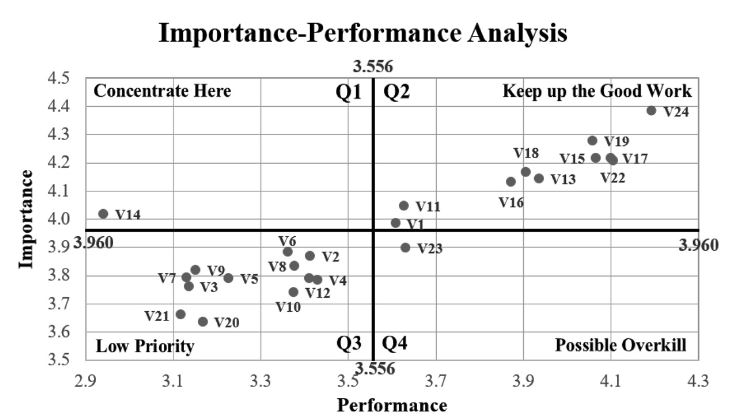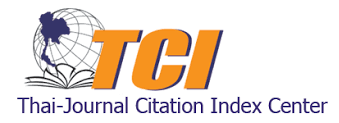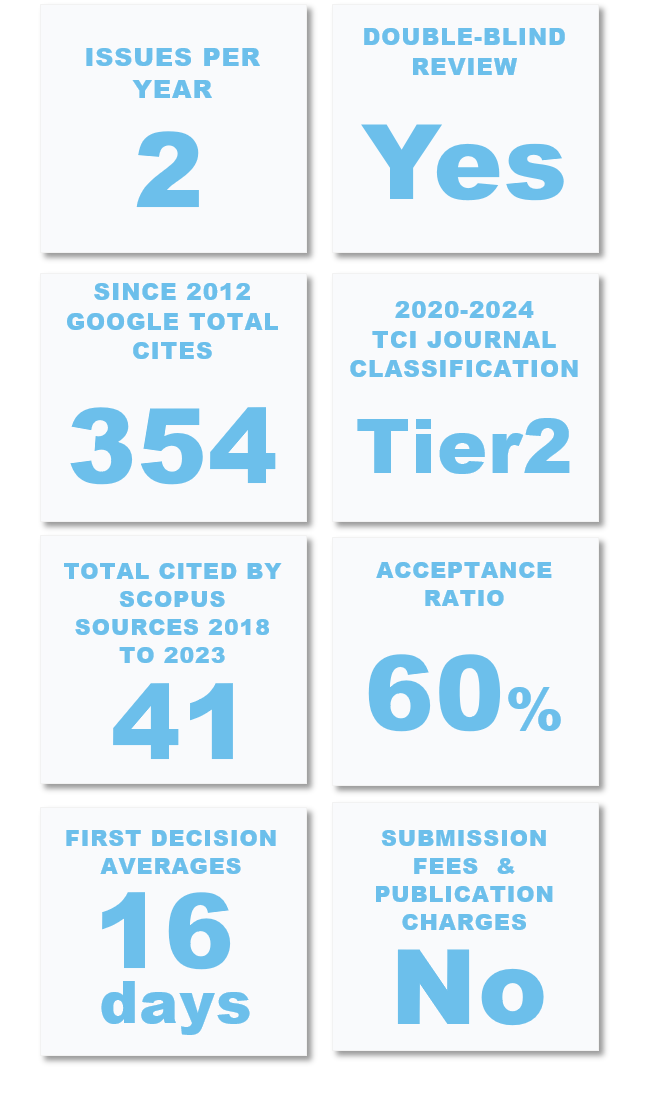An Application of Importance-Performance Analysis (IPA) for Evaluating City Bus Service Quality in Cambodia
Keywords:
Importance-Performance Analysis, Service quality, Users’ expectations, Users’ perceptions, User Satisfaction, CambodiaAbstract
The purpose of this paper is to evaluate the service quality of city bus in Cambodia. In this research, Importance-Performance Analysis (IPA) was applied with the focus on assessing the city bus service quality from the users’ viewpoints. In order to evaluate the service quality, the twenty-four items were grouped into five different factors concerning Bus Services, Bus Stop Facilities, Driver Attitude, Vehicle, and Bus Capacity with the use of five-point Likert scale. On a five-point Likert scale, face to face survey was performed to grasp the users’ expectations and perceptions on the service quality, resulting from 500 respondents. The IPA, a strategic tool, is composed of four quadrants namely: (1) Concentrate Here; (2) Keep up the Good Work; (3) Low Priority: and (4) Possible Overkill, resulting to identify the attributes of service which need to be improved immediately and the ones which are not essential currently, the ones which are overestimated, and the criterions that are satisfactory. Finally, the graphical results play a critical role for the government authorities/agencies to find out the focus areas for an improvement of city bus service quality.
Downloads
References
Abalo, J., Varela, J., & Manzano, V. (2007). Importance values for Importance–Performance Analysis: A formula for spreading out values derived from preference rankings. Journal of Business Research, 60(2), 115-121.
Azzopardi, E., & Nash, R. (2013). A critical evaluation of importance–performance analysis. Tourism Management, 35, 222-233.
Bordagaray, M., dell’Olio, L., Ibeas, A., & Cecín, P. (2014). Modelling user perception of bus transit quality considering user and service heterogeneity. Transportmetrica A: Transport Science, 10(8), 705-721.
Cafiso, S., Di Graziano, A., & Pappalardo, G. (2013a). Road safety issues for bus transport management. Accident Analysis & Prevention, 60, 324-333.
Cafiso, S., Di Graziano, A., & Pappalardo, G. (2013b). Using the Delphi method to evaluate opinions of public transport managers on bus safety. Safety science, 57, 254-263.
Carreira, R., Patrício, L., Jorge, R. N., & Magee, C. (2014). Understanding the travel experience and its impact on attitudes, emotions and loyalty towards the transportation provider–A quantitative study with mid-distance bus trips. Transport Policy, 31, 35-46.
Chen, J.-K., & Chen, I. S. (2010). Disparities between services demanded and services received in Taiwanese restaurants.
Chou, C.-C., Liu, L.-J., Huang, S.-F., Yih, J.-M., & Han, T.-C. (2011). An evaluation of airline service quality using the fuzzy weighted SERVQUAL method. Applied Soft Computing, 11(2), 2117-2128.
Coghlan, A. (2012). Facilitating reef tourism management through an innovative importance-performance analysis method. Tourism Management, 33(4), 767- 775.
Cohen, J. F., Coleman, E., & Kangethe, M. J. (2016). An importance-performance analysis of hospital information system attributes: A nurses’ perspective. International journal of medical informatics, 86, 82-90.
Dabestani, R., Shahin, A., Saljoughian, M., & Shirouyehzad, H. (2016). Importance-performance analysis of service quality dimensions for the customer groups segmented by DEA: The case of four star hotels. International Journal of Quality & Reliability Management, 33(2), 160-177.
Davidson, M. C. (2003). Does organizational climate add to service quality in hotels?. International Journal of contemporary hospitality management, 15(4), 206-213.
De Oña, J., De Oña, R., Eboli, L., & Mazzulla, G. (2013). erceived service quality in bus transit service: a structural equation approach. Transport Policy, 29, 219-226.
Deb, S., & Ahmed, M. A. (2018). Determining the service quality of the city bus service based on users’ perceptions and expectations. Travel Behaviour and Society, 12, 1-10.
Dwyer, L., Cvelbar, L. K., Edwards, D., & Mihalic, T. (2012). Fashioning a destination tourism future: The case of Slovenia. Tourism Management, 33(2), 305-316.
Eboli, L., & Mazzulla, G. (2011). A methodology for evaluating transit service quality based on subjective and objective measures from the passenger’s point of view. Transport Policy, 18(1), 172-181.
Figini, M. (2003). Dare valore alle esigenze dei clienti e dei dipendenti dell’azienda. Con la customer satisfaction ed i gruppi di miglioramento aziendale: FrancoAngeli.
Figler, S. A., Sriraj, P., Welch, E. W., & Yavuz, N. (2011). Customer loyalty and Chicago, Illinois, transit authority buses: Results from 2008 customer satisfaction survey. Transportation research record, 2216(1), 148-156.
Foote, P. J., & Stuart, D. G. (1998). Customer satisfaction contrasts: express versus local bus service in Chicago’s North Corridor. Transportation research record, 1618(1), 143-152.
Frauman, E., & Banks, S. (2011). Gateway community resident perceptions of tourism development: Incorporating Importance-Performance Analysis into a Limits of Acceptable Change framework. Tourism Management, 32(1), 128-140.
Freitas, A. L. P. (2013). Assessing the quality of intercity road transportation of passengers: An exploratory study in Brazil. Transportation Research Part A: Policy and Practice, 49, 379-392.
Goh, K., Currie, G., Sarvi, M., & Logan, D. (2014). Factors affecting the probability of bus drivers being at-fault in bus-involved accidents. Accident Analysis & Prevention, 66, 20-26.
Griffin, T., & Edwards, D. (2012). Importance–performance analysis as a diagnostic tool for urban destination managers. Anatolia, 23(1), 32-48. doi:10.1080/13032917.2011.653630
Group, K. (2013). Transit capacity and quality of service manual.
Güner, S. (2018). Measuring the quality of public transportation systems and ranking the bus transit routes using multi-criteria decision making techniques. Case Studies on Transport Policy, 6(2), 214-224.
Hernandez, S., & Monzon, A. (2016). Key factors for defining an efficient urban transport interchange: Users’ perceptions. Cities, 50, 158-167.
Hu, X., Zhao, L., & Wang, W. (2015). Impact of perceptions of bus service performance on mode choice preference. Advances in Mechanical Engineering,7(3), 1687814015573826.
Jang, S., Ha, A., & Silkes, C. A. (2009). Perceived attributes of Asian foods: From the perspective of the American customers. International Journal of Hospitality Management, 28(1), 63-70. doi:https://doi.org/10.1016/j.ijhm.2008.03.007
JICA. (2014). The project for comprehensive urban transport plan in Phnom Penh Capital City (PPUMP).
Joewono, T. B., Tarigan, A. K., & Susilo, Y. O. (2016). Road- based public transportation in urban areas of Indonesia: What policies do users expect to improve the service quality?. Transport Policy, 49, 114-124.
Jomnonkwao, S., & Ratanavaraha, V. (2016). Measurement modelling of the perceived service quality of a sightseeing bus service: An application of hierarchical confirmatory factor analysis. Transport Policy, 45, 240- 252.
Jomnonkwao, S., Siridhara, S., & Ratanavaraha, V. (2015). Awareness status of sightseeing bus entrepreneurs: A case study in rural areas of Thailand. Lowland Technology International, 17(1), 47-52.
Lee, C.-K., Yoon, Y.-S., & Lee, S.-K. (2007). Investigating the relationships among perceived value, satisfaction, and recommendations: The case of the Korean DMZ. Tourism Management, 28(1), 204-214.
Lee, H.-S. (2015). Measurement of visitors’ satisfaction with public zoos in Korea using importance-performance analysis. Tourism Management, 47, 251-260.
Machado-León, J. L., de Oña, R., Baouni, T., & de Oña, J. (2017). Railway transit services in Algiers: priority improvement actions based on users perceptions. Transport Policy, 53, 175-185.
Martilla, J. A., & James, J. C. (1977). Importance-performance analysis. Journal of marketing, 41(1), 77-79.
Mohebifar, R., Hasani, H., Barikani, A., & Rafiei, S. (2016). Evaluating service quality from patients’ perceptions: application of importance–performance analysis method. Osong public health and research perspectives, 7(4), 233-238.
Mouwen, A. (2015). Drivers of customer satisfaction with public transport services. Transportation Research Part A: Policy and Practice, 78, 1-20.
Nocera, S. (2011). The key role of quality assessment in public transport policy. Traffic Engineering & Control, 52(9).
Nwachukwu, A. A. (2014). Assessment of passenger satisfaction with intra-city public bus transport services in Abuja, Nigeria. Journal of Public Transportation, 17(1),5.
Pan, F. C. (2015). Practical application of importance- performance analysis in determining critical job satisfaction factors of a tourist hotel. Tourism Management, 46, 84-91.
Phun, V. K., Pheng, P., & Yai, T. (2015). Using ordered probit modeling to assess perceived bus performance in Phnom Penh. Journal of the Eastern Asia Society for Transportation Studies, 11, 1155-1172.
Rasoolimanesh, S. M., Dahalan, N., & Jaafar, M. (2016). Tourists’ perceived value and satisfaction in a community-based homestay in the Lenggong Valley World Heritage Site. Journal of Hospitality and Tourism Management, 26, 72-81.
Ratanavaraha, V., Jomnonkwao, S., Khampirat, B., Watthanaklang, D., & Iamtrakul, P. (2016). The complex relationship between school policy, service quality, satisfaction, and loyalty for educational tour bus services: A multilevel modeling approach. Transport Policy, 45, 116-126.
Shaaban, K., & Khalil, R. F. (2013). Investigating the customer satisfaction of the bus service in Qatar. Procedia-Social and Behavioral Sciences, 104, 865-874.
United Nations. (2018). World Urbanization Prospects. Retrieved from https://population.un.org/wup/
Van Ryzin, G. G., & Immerwahr, S. (2007). Importance- performance analysis of citizen satisfaction surveys. Public Administration, 85(1), 215-226.
Verbich, D., & El-Geneidy, A. (2016). The pursuit of satisfaction: Variation in satisfaction with bus transit service among riders with encumbrances and riders with disabilities using a large-scale survey from London, UK. Transport Policy, 47, 64-71.
Vetrivel Sezhian, M., Muralidharan, C., Nambirajan, T., & Deshmukh, S. (2014). Attribute-based perceptual mapping using discriminant analysis in a public sector passenger bus transport company: A case study. Journal of Advanced Transportation, 48(1), 32-47.
Wang, M., Wang, J., & Zhao, J. (2007). An empirical study of the effect of customer participation on service quality. Journal of Quality Assurance in Hospitality & Tourism, 8(1), 49-73.
Ziegler, J., Dearden, P., & Rollins, R. (2012). But are tourists satisfied? Importance-performance analysis of the whale shark tourism industry on Isla Holbox, Mexico. Tourism Management, 33(3), 692-701.

Downloads
Published
How to Cite
Issue
Section
License
Copyright (c) 2019 International Journal of Building, Urban, Interior and Landscape Technology (BUILT)

This work is licensed under a Creative Commons Attribution-NonCommercial-NoDerivatives 4.0 International License.










